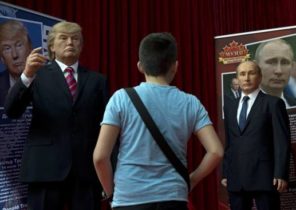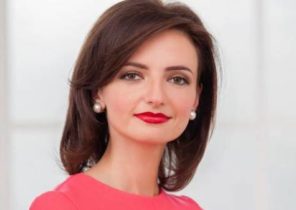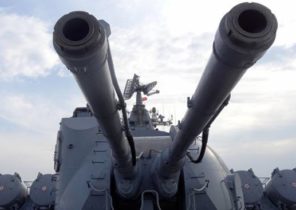From the hydrogen bomb to the conquest of space — most of the large-scale Soviet technology programs appeared in the closed cities. Scientists, engineers and workers lived there in isolation, protected from the outside world environment. After the Soviet collapse, these cities difficult to find a second wind. For example, the situation in Sarov, one of the centers of military nuclear research.
Every year 50,000 pilgrims come to Diveyevo to the relics of St. Seraphim (1754-1833). In the middle of the forest there is a stone on which Russian ascetic was praying all day long. A little further is the spring where people fill jars and bottles, and the believers are immersed in a small lake. Finally, all come to the porch, where everyone blesses the sign of the cross. Anyway, Sarov and its monastery, which is located only ten kilometers from here, are closed to visitors. This city, known until recently under the code name of Arzamas-16, is not allowed outsiders.
Diveyevo, surrounded by barbed wire agglomeration under military guard patrols did not appear on Soviet maps. All the locals were carefully selected, and they were charged with “forging the atomic shield of the country” after the Second world war. Now the former secrecy is lifted, and the city regained its former name, but access to it is strictly regulated. Only local residents (about 100 thousand) and received permission visitors can walk through a checkpoint at the entrance. Sarovchane bring the badge to the reader, enter the six-digit code and tested personality. Guests are asked to immediately put mobile phones, cameras and other means of communication. Then they are taken to be representative of the Protocol service sent the invitation enterprise that will be responsible for their movement up to the check-out through the same checkpoint where they will return the personal items.
Surprisingly, the ROC easily accepted limits pilgrims ‘ access. On the 60th anniversary of the formation of 12 management of the Ministry of defense of the USSR (it was responsible for the military nuclear program) in 2007, on the occasion which was organized at the Cathedral of Christ the Savior, President Vladimir Putin noted the reconciliation of the governmental engineers and spiritual authorities in 1990. Sarovskie nuclear physicists returned to the Church surviving buildings of the monastery, and the Patriarch responded by declaring Seraphim their patron Saint!
As they say in Sarov, he twice in the history became the Savior of Russia: the power of the spirit and of the atom. At the Yalta conference in February 1945, Stalin shared with British Prime Minister Churchill and US President Roosevelt allay fears that London and Washington could unleash a conflict with Moscow. He never thought that his prediction would come true so soon: barely having dealt with Berlin, the allies began to discuss the possibility to use the existing strategic advantage and end the war weakened the USSR. July 16, the threat took shape: the Manhattan project ended the first explosion of the atomic bomb in the desert of new Mexico. This was followed by the August destruction of Hiroshima and Nagasaki, which dispelled the last doubts about America’s readiness to use the new weapons.
The Soviet government saw this as a direct warning to the address: the country was weakened by the deaths of 26 million people and the destruction of the industry and the threat from the allies of yesterday seemed no less than that four years earlier, came from the Nazis. As a result, the Council of Ministers of 20 August 1945, there were two historic decisions: activate scientific research to restore strategic parity with the West and the preservation of complete secrecy, so as not to provoke the enemy ahead of time.
Since the end of 1945 was launched the search for the perfect place to centralize a top-secret research. After much deliberation involved in the implementation of the project working group under the supervision of Lavrenty Beria opted for Sarov, 350 km to the East from Moscow. The village and several surrounding villages with a total population of 9 500 people were cut off from the territorial administration of the Republic of Mordovia and erased from all maps and official documents. As for the local population, workers producing shells of factory No. 550 remained in place, and others moved beyond the exclusion zone.
On the background of the influx of workers and specialists, the settlement became a small city: there they began to build apartment buildings, there is a need in our own hospital, stadium, culture house, library, theater and Park. The construction was carried out hastily, without plan and budget. To win time, the laboratories were placed in the monastery’s premises. Among the involved construction workers were representatives of the “special contingent”, as it was called prisoners in official documents.
The security services had checked the family history “third-generation” each person, whether an engineer or the design office working on the construction of one set of objects. Involved employees could leave only with the permission of the security services. Permission for personal reasons were given in driblets. Vacation outside the zone was prohibited, but it is compensated financially. A significant privilege for the time was that the shops in Sarov were supplied better than in the rest of the country.
The city was given the code name Arzamas-16. Since then, the use of traditional names became equated with disclosure of secrets. Private correspondence was via a special Inbox “Moscow Centre 300”. In addition, the names of city streets consistent with Moscow so that went well beyond the employees of KB-11 were able to pass the test documents without arousing suspicion from the police.
The need for secrecy and isolation had very different psychological effects on people. So, the physicist Andrei Sakharov wrote in his memoirs about the crushing imprisonment. Vladimir Matyushkin, on the contrary, noted the flexibility in charge of security officials. Hard constraints have made the Sarov closed off from the world the monastery for engineers. “True faith cannot be without works: who verily believes, he certainly has a case,” — said St. Seraphim of Sarov. This Maxim is perfectly fitted to scientists of Sarov, who spent a few hours of free time for conversations about critical mass and concentration of neutrons.
Tops basic science
Exhausted groups of scientists, who almost killed themselves with work, hardly needed a new stimulus, but on 12 March 1947, President Harry Truman outlined his famous doctrine, which marked the beginning of the cold war. The General staff has prepared Washington plan “dropshot”, finally took shape in the early 1950s. He suggested a sudden attack on the Soviet Union with discharge 200-300 atomic bombs on major industrial, military and research centers.
The result of coordinated work of outstanding scientists, engineers and designers, as well as intelligence and “atomic spies”, was the creation in just two years the first Soviet nuclear bomb, code named RDS-1. Several decades later, one of the program Directors Yuli Khariton said about that period: “I am amazed and admire what was done by our people in 1946-1949 years… This period of tension, heroism, creative takeoff and dedication is beyond description. (..) Four years after the end of mortal combat with fascism, our country abolished the monopoly of the US possession of the atomic bomb.”
Being at the forefront of this feat sarovskie specialists furnish four years later, the United States, creating the first hydrogen bomb. Note that this was achieved against the background of parallel recovery of the devastated and bled white by the war-torn country. Wealthy at that time, by contrast, the US had huge financial resources and incomparable MIC. In 1950 the American economy was 27% of world GDP, and the Soviet — only 9.6%.
This model is a closed settlement around the “main enterprise” has been used in many parts of the Soviet atomic chain. Although Sarov was the center of the atomic project, which aspired to the heights of fundamental research, their contribution to national efforts have been made, and dozens of other similar objects. So, since 1945, a number of small Ural and Siberian cities were selected for the supply of raw materials for experiments. In 1946, the prototype reactor of the Institute “the lighthouse” started the production of military plutonium in the closed city of Ozersk, near Chelyabinsk (code-named Chelyabinsk-65). In 1949, in Tomsk-7 have launched a secret production of uranium-235. Here the research is increasingly focused on the solution in Arzamas-16 practical problems.
Political prisoners and criminals from the Gulag was used for the most dangerous jobs like mining uranium ore and manipulation recepsionist substances in accordance with a cynical Stalinist principle that even the enemies of the people can play a role in the construction of socialism. As the historian Yuri Fedorov, in 1945 the NKVD and provided the project 13 camps with 103 000 prisoners. Later to this were added 190 000 prisoners who were sent to mine minerals. How many of them have returned back?
Once established the theoretical research and the supply of raw materials needed to build a test site in a desert area with suitable geological conditions. The choice fell on the Kazakh steppe near Semipalatinsk. Speech again went about the enormous amount of construction around the proposed hub buildings, bunkers and underground station to estimate the destructive power of the device. Workers, as well as biologists, physicists and other professionals who had to study the destructive properties of the shock wave and radiation, is located a hundred kilometers to the East, where there is another top secret city — Moscow-400.
The salvation of the homeland
Today don’t need permission to go to this village with a population of just over a thousand people. Kurchatov (it was renamed in honor of Director of the Soviet nuclear program) has lost its former luster, though sometimes he still lurks: tiled pavement surrounded by trees, dilapidated buildings in the Stalinist style, old-fashioned hotels.
There is still nuclear physics Institute, which creates, in collaboration with Japanese scientists model to test crisis situations at the research reactor, located on the territory of the former test site. Also preserved from the Soviet times, the Institute of radiation safety is still closed to outsiders. Nevertheless there you can visit the Museum of the landfill and to get acquainted with the history of the Soviet bomb on the scale maps and black-and-white photographs. Seismographs, Geiger counters, cameras, and even the command console, which was ordered to explosion — all this solemnly gathering dust there. The guide even invites you to go to the “office Kurchatov”, where he worked during a short travel of the object during the testing period. Park “Park of nuclear technologies” is intended to revive the scientific nature of the city.
The network of closed nuclear cities formed a broad community of scientists, engineers and testers, which were aimed solely at protecting the homeland against new threats. “Paradoxically, closed from the rest of the city was linked by thousands of threads with hundreds of organizations and companies huge powers are much stronger than many of the giants of the domestic industry in the largest cities, writes Vladimir Matyushkin in the “Daily life of Arzamas-16″. — And, perhaps, many of its inhabitants is much sharper than most of the Soviet people, was to feel the pulse of the whole world, of the planet. And their place in history, its relationship with world events can be, sometimes unconsciously, felt by every resident of the city and proud of it”.
Whatever it was, the heroic age could not last forever, and full mobilization of the forces was to lead to the depletion of the system. The Soviet leadership ultimately mired in the stagnant conformism, and the industrial machine was experiencing stagnation and degradation. People are tired of the fact that the government no end of pushing him to feats, and ate a bit. He was tired to tolerate the regime, since he was not able to give him not that the ideal of equality and brotherhood, and even consumer goods, about which it dreamed, and from which so much was abandoned because of the need and crises. People are disappointed, many began to drink. Mikhail Gorbachev set right the problem, but he has failed to solve it.
1990-e years were lost in trying to build a market economy on the ruins of the five democratic at the same time risky initiatives. Russian and foreign economists had estimated the benefits of a particular transitional programs, and much more prosaic oligarchs have bought up for pennies of the company and the oil mills, the steel industry, aluminum plants, mines, chemical plants. Bankruptcy followed one another. Unemployment went up the hill, resisting the storm of the enterprise paid out a wages in depreciated rubles. The principle of “save yourselves who may,” swept all spheres of society, which one after the other lost funding, whether health or education, the police or the courts.
The flash of hatred, the rise of separatism. The war in Chechnya has caused among the shocked and humiliated population is not enthusiastic, and unhealthy vindictiveness. Everyone was waiting for that rebellious Republic to quickly rein (a matter of two hours airborne division, as promised by the Minister of defence Pavel Grachev), but the army is deeply mired in a bloody quagmire.
Russian Communists (they were just one of many political parties) criticized the demographic consequences of the purges, repressions and labor camps of the Soviet era, but those pointed out in response to the equally terrible, in their opinion, the impact on the age pyramid due to the “shock therapy” of liberalism for 15 years after the collapse of the Soviet system: from 1992 to 2008, the death rate exceeded the birth rate by 11 million. The reason for this was the collapse of health care, the explosive growth of crime, the surge of suicides, accidents of all sorts, the war in Chechnya. From 1990 to 1994, life expectancy of Russians has shown a sharp decline, from 65 to 58 years for men and from 74 to 71 years for women (later she started very slowly growing).
In such circumstances, the closed cities lived as the last pearls of the Empire. In such a relatively separated spaces people lived among their own, away from corruption and from the worst of its manifestations, from the mafia and crime. In addition, squandered in other parts of the Soviet scientific apparatus remained there away from the eyes of those who have crossed over to liberalism. There continued to engage in such things as the production of fissionable materials (for military and civil purposes), fuel processing, disarmament and development for new weapons.
These cities, which were originally considered simply as bedroom communities for employees of city-forming enterprise (it worked almost all the locals), has gone the way of diversification. There are shops, restaurants, cinemas and shopping malls, even travel agencies and real estate agencies. To the extent that, as a scientific activity has experienced a slowdown amid post-Soviet economic disaster, the labor force migrated to more profitable civilian industries. Utilities (electricity, water, public transport), and recreational, cultural and sports infrastructure are now in the hands of the municipality or the private sector. Even kept closed scientific towns pass to a normal life, and may retain cultural characteristics.
Invite kravchinina the opening of the city, and he will answer you: “no way”. Although today the benefits of the Soviet times are gone, from secrecy had not disappeared, and each is free to correspond with the outside world, the residents of closed cities hold on to their inner circle. Veterans of the heroic age left us, but their children and grandchildren are still here. Half of them are still working in enterprises, where the entire dynasty of scientists and engineers are working on technological progress in a number of civilian and military industries. Upgraded research centres and refineries continue research towards “clean peaceful atom”. Although this ideal is not achieved, although they would operate under IAEA supervision and according to the norms that are far removed from those times, when the river was considered the best way to get rid of hazardous substances.
The emergence of “technology parks”
The other half decided to work in startups and sub-contractors of the main company. For example, in the Sarov Association “BINAR” it’s been fifteen years side by side a variety of high-tech projects: intraocular lenses, instruments noncontact detection of the plane of the sheet metal after the exit from the rolling machine, sensors to ensure the safety of nuclear power plants. A higher scientific level, the peaceful atmosphere of the small town and the proximity of specialized companies contribute to the emergence of new high-tech projects. This also explains the lower rate of unemployment (4% versus 6% nationally). By the way, this subculture supported the club closed cities, which will hold a local exchange, internships and vacation.
Anyway, some of the former closed cities have become common. For example, Obninsk, where he established the first civilian nuclear plants with the Dubna particle accelerator and research center or Zagorsk-7, where they closed the Institute, engaged in the development of bacteriological weapons. The same applies to centers of space research, which was transferred to civic rails since 1986. Closed left only those cities that belong to the Ministry of defense and Rosatom: in total there are about 40. The scientific archipelago gradually melts in the ocean normal.
Under the supervision of Rosatom is about ten closed cities with research centers, enterprises enrichment and reprocessing. Iran, India, China and Bangladesh — volume of orders exceeds $ 100 billion, and currently builds three dozen nuclear power plants. In the space sector is a bit outdated, but reliable Russian technology has become a key element of international cooperation around the ISS. Many of the systems from the modules to the rescue rocket engines have long been used in American and European rockets.
The results of other efforts technical breakthrough less impressive, for example, in the field of artificial intelligence, supercomputers, nanotechnology and medical research. Established in 2011 by Anatoly Chubais (one of the authors of “shock therapy”) the state Corporation “Rosnano”, for example, failed to achieve the promised technological revolution, though, and got ourselves an unjustified tax benefits, which was pointed out in the chamber.
Russia will not be able to repeat the feats of the postwar scientific program, which was implemented in a much more difficult and painful period? The transition to capitalism cut off her wings? In any case, she keeps trying. With the beginning of the century every self-respecting city, region, and SOE is trying to create its own incubator, Technopolis, research center, a hotbed of startups. Parks (they may relate to research centres or to be the result of a partnership between the state and the private sector) are growing like mushrooms after the rain 1990-ies. At the end of the 2019 year was 169. They offer creatively-minded entrepreneurs in an environment that should promote the development of their project.
However, as noted by the Association of industrial parks, the success rate of startups in them is quite low: incubation period survive only 27% of enterprises vs. 87% in the U.S. and 88% in Europe. Maybe these are the consequences of idealized Russian legends about the company, which was created in the garage is unknown, but is ready to change the world geniuses.
Of course, bill gates, Steve jobs and mark Zuckerberg do not have created the technology, promotion of which so brilliantly provided. The fact that the main component of success (as evidenced by history of closed cities, as well as Silicon valley and Massachusetts Institute of technology) — not a garage, and a long research with state funding. The exact opposite of the seething disordered initiatives.







